Miniature Pinscher
 Miniature Pinscher | ||||||||||||||||||||||||||
| Other names | Zwergpinscher | |||||||||||||||||||||||||
|---|---|---|---|---|---|---|---|---|---|---|---|---|---|---|---|---|---|---|---|---|---|---|---|---|---|---|
| Common nicknames | Min Pin, King of the Toys | |||||||||||||||||||||||||
| Origin | Germany | |||||||||||||||||||||||||
| ||||||||||||||||||||||||||
| Domestic dog (Canis lupus familiaris) | ||||||||||||||||||||||||||
The Miniature Pinscher (Zwergpinscher, Min Pin) is a small breed of dog originating from Germany. The breed's earliest ancestors may have included the German Pinscher mixed with Italian greyhounds and dachshunds.[1][2]
Historical artifacts and paintings place the Min Pin as a very old breed, but factual documentation began less than 200 years ago, leaving their actual origins to debate. The Miniature Pinscher is reported to include the Dachshund and Italian Greyhound among its ancestors. Many historians and those who have researched the background of the breed agree that this heritage is most likely, adding the shorthaired German Pinscher to the family tree. The international kennel club, the Fédération Cynologique Internationale, lists the Miniature Pinscher in Group 2, Section 1.1 Pinscher, along with the Dobermann, the German Pinscher, the Austrian Pinscher, and the other Toy Pinscher, the Affenpinscher.[3] Other kennel clubs list the Miniature Pinscher in the Toy Group or Companion Group.
Etymology


The misconception that the Miniature Pinscher is a "miniature Doberman" occurred because the Doberman Pinscher (a breed developed by Karl Friedrich Louis Dobermann around 1890) was introduced to the US before the Miniature Pinscher. In 1919 the Miniature Pinscher was introduced to the AKC show ring. At the time, not knowing that it was referred to officially in Germany as the Zwergpinscher (little biter), the AKC referred to the breed as simply "Pinscher" and listed it in the miscellaneous category. When the Miniature Pinscher Club of America (MPCA) was created in 1929 (the year of the breed's official introduction into the AKC), they petitioned for Miniature Pinschers to be placed in the Toy group. The AKC's description, that the dog "must appear as a Doberman in miniature", led to the misconception common today that this breed is a "Miniature Doberman Pinscher".
The original name for this breed in the US was "Pinscher (Toy)" until 1972 when the name was officially changed to Miniature Pinscher.[4]
History
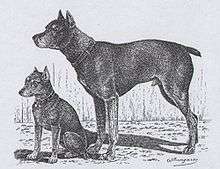
Historical artifacts and paintings indicate that the "Min Pin" is a very old breed, but factual documentation begins less than 200 years ago,[1] which leaves the breed's actual origins open to debate. There is a drawing by Jean Bungartz, published in 1888 comparing the Miniature Pinscher to the German Pinscher.
Description
Appearance
The Miniature Pinscher is structurally a well balanced, sturdy, compact, short-coupled, smooth-coated dog. They are naturally well groomed, vigorous and alert. Characteristic traits are their hackney-like action, fearless animation, complete self-possession, and spirited presence. Legs should be straight with no bending in or out.[5] The Miniature Pinscher frequently has a docked tail and cropped ears, though the AKC no longer requires ear cropping for shows.
Size
According to the American Kennel Club, the Miniature Pinscher should be 10–12 1⁄2 inches (25–32 cm) high with most desirable height 11–11 1⁄2 inches (28–29 cm) at the highest point of the shoulder blades. Length is equal to height, though females may be slightly longer.[5] The ideal weight is 8–10 pounds (3.6–4.5 kg).[6]
Coat and color


The coat is short and smooth, with no undercoat. Available colors include solid red, stag red, blue stag red, chocolate stag red, fawn stag red, as well as black, chocolate, blue, and fawn with tan points or rust points. For showing in the United States, AKC disqualifies all colors but the solid or stag red and the black or chocolate with rust points.[7] The Pinscher-Schnauzer Club, which maintains the standard for showing in Germany, has the same restrictions.[8] In the UK, blue with rust points is allowed in the show ring.[9] White spots larger than half an inch or black spots on the points are disqualifications for showing in most countries. Merle is not an accepted coloring of the breed.
Care
Grooming is easy, as the smooth, short-haired coat requires little attention, needing only occasional brushing and shampooing.[5] Care must be taken in cold weather. Sweaters or baby blankets for a Miniature Pinscher keep it from getting too cold.[10] Miniature Pinschers are an active breed and need access to a fenced yard, or be given a daily walk.[11]
Temperament
Miniature Pinschers are for experienced dog owners. The Miniature Pinscher is an assertive, outgoing, active and independent breed.[11] Miniature pinschers are energetic and need a fenced in yard to run in; they make great agility dogs. They are great escape artists and some recommend having a kennel with a lid on it for them to run around in.[11] They are good watch dogs, as they are alert and wary of strangers.[5][12]It is recommended that adults and teenagers, rather than young children, play with a Miniature Pinscher as younger children play rough.[13]
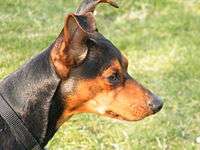 Miniature Pinscher, uncropped ears
Miniature Pinscher, uncropped ears Miniature Pinscher
Miniature Pinscher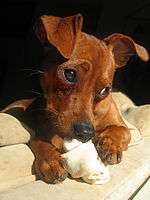 Miniature Pinscher
Miniature Pinscher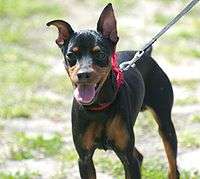 Miniature Pinscher, cropped ears and tail
Miniature Pinscher, cropped ears and tail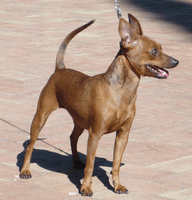 A red Miniature Pinscher
A red Miniature Pinscher A red Miniature Pinscher and a chocolate and tan Miniature Pinscher
A red Miniature Pinscher and a chocolate and tan Miniature Pinscher
References
- 1 2 "Miniature Pinscher History". American Kennel Club. Archived from the original on 21 February 2014. Retrieved 18 September 2011.
- ↑ The Miniature Pinscher is not a scaled-down, version of anything, especially the much larger Doberman Pinscher, although both are likely descended from the German Standard Pinscher. It is a distinctly German breed often referred to as the Zwerg or Dwarf Pincher in historical documents. German Kennel Club documents also refer to the Miniature Pinscher as the "reh" Pinscher, but this term is only used for a dog of stag-red color, "reh" referring to a small red deer found in German forests years ago. The one fact remains that the Miniature Pinscher originated several centuries ago as an efficient barnyard ratter, with no relation to the Doberman or the Manchester Terrier. The Miniature Pinscher is reported to include the Dachshund and Italian Greyhound among its ancestors. Many historians and those who have researched the background of the breed agree that this heritage is most likely, adding the shorthaired German Pinscher to the family tree. (American Kennel Club)
- ↑ "Zwergpinscher". Fédération Cynologique Internationale. Retrieved 14 October 2016.
- ↑ "Miniature Pinscher History". Miniature Pinscher Club of America. Retrieved 14 October 2016.
- 1 2 3 4 "Miniature Pinscher Breed Standard". American Kennel Club. Archived from the original on 10 April 2012. Retrieved 18 September 2011.
- ↑ "Ideal Weight Ranges". Association for Pet Obesity Prevention. Retrieved 14 October 2016.
- ↑ "Miniature Pinscher - Colors and Markings". American Kennel Club. Archived from the original on 5 May 2012. Retrieved 10 May 2013.
- ↑ "Zwergpinscher Standard" (PDF). Pinscher-Schnauzer Klub (in German). Retrieved 10 May 2013.
- ↑ "Kennel Club UK Miniature Pinscher Breed Standard". Kennel Club UK. Retrieved 10 May 2013.
- ↑ "Miniature Pinscher". Animal-World. Retrieved 18 September 2011.
- 1 2 3 Sandhorst, Cindy. "Miniature Pinscher Breed Profile". Rescue Every Dog. Retrieved 18 September 2011.
- ↑ "Miniature Pinscher - Did you know?". American Kennel Club. Archived from the original on 5 May 2012. Retrieved 18 September 2011.
- ↑ "Miniature Pinscher Temperament and Behavior". Vet Info. Retrieved 18 September 2011.
External links
| Wikimedia Commons has media related to Miniature Pinscher. |